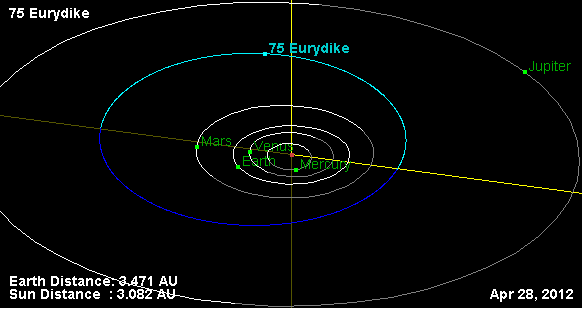75 Eurydike
Contributors to Wikimedia projects
 Article Images
Article Images
75 Eurydike is a large main-belt asteroid. It has an M-type spectrum and a relatively high albedo and may be rich in nickel-iron.[5] Eurydike was discovered by German-American astronomer C. H. F. Peters on September 22, 1862. It was second of his numerous asteroid discoveries and is named after Eurydice, the wife of Orpheus. The asteroid is orbiting the Sun for a period of 4.37 years and completes a rotation about its axis every 5.4 hours.
 Orbital diagram | |
| Discovery | |
|---|---|
| Discovered by | Christian Heinrich Friedrich Peters |
| Discovery date | September 22, 1862 |
| Designations | |
| (75) Eurydike | |
| Pronunciation | /jʊˈrɪdɪkiː/[1] |
Named after | Eurydice |
| Main belt | |
| Adjectives | Eurydikean /ˌjʊərɪdɪˈkiːən/ |
| Orbital characteristics | |
| Epoch December 31, 2006 (JD 2454100.5) | |
| Aphelion | 521.874 Gm (3.489 AU) |
| Perihelion | 278.028 Gm (1.858 AU) |
| 399.951 Gm (2.674 AU) | |
| Eccentricity | 0.305 |
| 1596.687 d (4.37 a) | |
Average orbital speed | 17.79 km/s |
| 26.318° | |
| Inclination | 5.002° |
| 359.481° | |
| 339.566° | |
| Physical characteristics | |
| Dimensions | 62.377 ± 1.603 km[2] |
| Mass | (4.46 ± 2.06/1.06)×1017 kg[3] |
Mean density | 3.511 ± 1.618/0.837 g/cm3[3] |
| 5.357 h[2] | |
| 0.149[4] | |
| M[5] | |
| 9.29[2] | |
References
- ^ 'Eurydice' in Noah Webster (1884) A Practical Dictionary of the English Language
- ^ a b c "75 Eurydike". JPL Small-Body Database. Jet Propulsion Laboratory. SPK-ID: 20000075. Retrieved 29 March 2024.
- ^ a b Fienga, A.; Avdellidou, C.; Hanuš, J. (February 2020). "Asteroid masses obtained with INPOP planetary ephemerides". Monthly Notices of the Royal Astronomical Society. 492 (1): 589–602. doi:10.1093/mnras/stz3407.
- ^ Asteroid Data Sets Archived 2009-12-17 at the Wayback Machine
- ^ a b Busarev, V. V. (January 1998). "Spectral Features of M-Asteroids: 75 Eurydike and 201 Penelope". Icarus. 131 (1): 32–40. Bibcode:1998Icar..131...32B. doi:10.1006/icar.1997.5847.
External links
- 75 Eurydike at AstDyS-2, Asteroids—Dynamic Site
- 75 Eurydike at the JPL Small-Body Database
This article about an asteroid native to the asteroid belt is a stub. You can help Wikipedia by expanding it. |